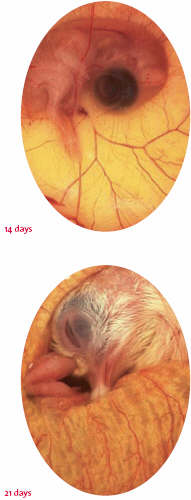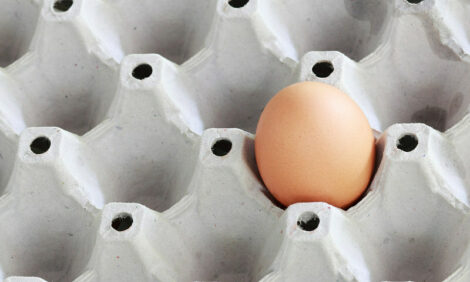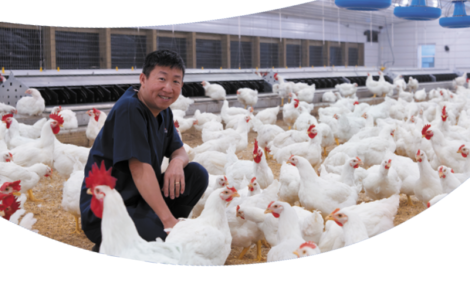



Single stage incubation has big advantages for turkeys
By Pas-Reform - The demand for the single stage incubation of turkey eggs is being stimulated by a greater awareness of the growing variability between batches of eggs, which is determined by flock age and genetic background.
Single-stage incubation
has been shown to improve hatchability and chick-quality
whatever the egg type, with the added advantage that after
each incubation cycle, the incubators can be cleaned and
thereby minimise the risks of spreading microbial
contamination.
In the multi-stage incubator, the climate is controlled to an
‘average’ to cope with the age of the different batches of
embryos in the incubator, and fluctuates from day to day
– which makes it difficult to support optimal, uniform
embryonic development for all the embryos. Conversely,
single stage incubation allows incubation conditions to be
adjusted precisely to the requirements of the eggs and the
embryos growing in them. However, to take full advantage
of the benefits of single stage incubation, two conditions
must be met. Firstly, we require knowledge of the specific
conditions needed to best support and optimise turkey
development, and secondly, incubators must be designed to
provide a homogeneous climate among all the eggs in each
section of the incubator.
In the following paragraphs, we briefly review the scientific
knowledge currently available regarding the embryonic
development of turkey and the climatic conditions needed
to produce day old poults of optimum vitality and the
highest uniformity.
The different phases of embryonic development
 A turkey embryo at 7, 14 and 21 days of incubation |
Differentiation
Embryonic differentiation is characterised by the initial
formation of different tissues that will develop into the final
organs during the growth and maturation phase. Cell
differentiation starts in the female, when the single-cell
oocyte divides many times, such that before incubation the
embryo consists of about 10,000 cells. The freshly laid
turkey egg embryo consists of a plate of cells with a cluster
of large cells in the centre. This cluster forms the area alba
unique to the turkey embryo. The area alba disappears
during the first hours of incubation. At this stage, the turkey
embryo is at an earlier stage of development than the
chicken embryo.
The differentiation phase is further characterised by a
‘folding’ of the early embryo, the gastrula, to form a three
dimensional structure in which premature structures of the
head and heart can be recognized within 36 hours.
Movement of cells mediates this folding process, whereby
the cells in the early gastrula ‘travel’ from one side to the
other. This process is highly temperature dependent.
In the differentiation phase, not only do the embryonic
structures develop, but also the extra-embryonic tissues -
such as the amnion and chorio-allantois, both essential
structures for the optimum exchange of oxygen/carbon
dioxide and the transport of nutrients from the yolk to the
embryo.
Growth
During differentiation the premature organs are formed and
the basic body pattern is laid down. Relatively minor
changes in the size of the embryo are seen in this phase of
development. Embryonic growth is characterised by an
increase in mass while the development of the organs
continues. The shape of the organs and, finally, the embryo is
determined by the rate of growth at a specific time in the
different parts of the embryonic body.
Temperatures below the optimum incubation temperature
of 37.5-37.8 ºC (99.5-100 ºF) can result in disproportional
growth: some embryonic cells and structures may grow
while others do not, which can result in a malformed
embryo.
The increase in mass during the growth phase is the result
of high metabolic activity and cell proliferation. The fuel for
this activity is delivered by the nutrients from the egg and
oxygen via the eggshell, with carbon dioxide and metabolic
heat produced as by-products of embryonic metabolism.
Growth rates decline when the porosity of the eggshell
becomes a limiting factor in the supply of sufficient oxygen.
This occurs earlier in eggs from older hens than from
younger turkey flocks, because the growth rate of embryos
from older flocks is higher.
The growth rate - and thereby the length of the incubation
period - depends mainly on temperature and is influenced
by flock age and the length of the storage period. Turkey
eggs generally hatch at 660-672 hours (27.5-28 days),
depending on the breed.
Maturation
During the final phase of development, the embryo undergoes a series of events that enable it to survive outside the protective environment of the shell. The rate of metabolism stabilises and reaches the so-called ‘plateau phase’ at about the 25th day of incubation. At the plateau phase, the growth rate declines because the embryo needs more oxygen than the porosity of eggshell can deliver - and to be able to use yolk fat as an energy source, the availability of oxygen is essential. So at this phase, the embryo suffers from anaerobic conditions, and must depend on carbohydrates (sugars), for energy during the hatching period. The healthy turkey embryo accumulates glycogen in vital tissues like the heart and liver, to ensure survival during the energy demanding process of maturation and hatching. It has been suggested by Christensen and colleagues (1999) that lines selected for growth or egg production differ in glycogen metabolism and the accumulation of glycogen stores during the maturation phase. These line specific differences may explain the different responses of the genetic lines on varying incubator climates.
Different egg types
The variability between egg types is determined by flock age
and genetic background. In turkey, maternal age has a
significant influence on egg composition . For example, eggs
laid early in the production cycle have a lower yolk/albumen
ratio compared to eggs laid by older flocks (reviewed by
Applegate TJ. (2002), and embryos from older hens reach the
plateau phase earlier than those from younger hens.
Eggshell conductance increases with flock age, but does not
change after the mid-lay period, which may explain the
declined hatchability we see at mid- to late production.
Embryonic growth in eggs from older hens is greater and
results in higher hatching poult weights, as a proportion of
egg weight compared to the poults from the younger flocks.
Christensen et al. (2001) showed that both the length of the
incubation period and hatchability are affected by the
genetic background and maternal age of the breeder flocks.
The hatchability of eggs from a line selected for body weight
is significantly lower when compared to the hatchability of a
line selected for egg production (Table 1). Selection for
growth results in bigger eggs, while selection for increased
egg production has no effect on egg size, as this is a
selection trait.
Genetic selection has also been shown to have an effect on
the porosity of the egg shell. The water vapour conductance
of the egg shell varies greatly between genetically different
lines, and was shown to be greatest in egg producing strains.
From this limited overview, we can conclude that batches of
turkey eggs delivered at the hatchery vary with flock age and
strain. The production of vital poults depends on whether
the hatchery manager has the tools to optimise the climate
conditions for each type.
Incubation conditions
Since the single stage incubator is filled at one time, it is important that the size of the incubator matches the number of eggs in the different batches – where a batch consists of a number of eggs from one flock and similar storage conditions. Incubators which enable climate conditions for each incubator section to be controlled separately are best adapted to the single stage incubation of small batches of different egg types. Fluctuations in market –demand for poults has direct consequences on the duration of storage for the eggs. Sometimes a longer storage period is unavoidable, and the negative effects of prolonged storage on hatchability and poult vitiality are well documented. Pre-storage incubation of 12 hr at 37.5 ºC (99.5 ºF) has been shown to improve the hatchability of turkey eggs, possibly because this treatment matures the turkey embryo to a point where it is more resistant to egg handling.
Temperature
Setting the correct temperature programme at the
incubator is the most important factor for successful single-stage
incubation. It is also essential that all eggs set in the
single-stage incubator are preheated to a homogeneous
temperature, to encourage embryonic development to start
simultaneously in each egg.
Generally the set point of the incubator temperature is
lowered as incubation progresses, since metabolic heat
production, and thus the risk of overheating the embryo,
increases as the embryo grows. To support optimum
embryonic development, the temperature programme
should follow a temperature pattern that is as close to
‘natural’ as possible, from 37.8 ºC (100 ºF) during the first
two-thirds of incubation and increasing to about 38.1 ºC
(100.6 ºF) during the final phase. Embryo temperature is
represented by eggshell temperature, which can be used as
the leading parameter for creating optimum temperature
patterns. The storage of eggs affects hatchability and poult
quality, and dictates that the incubation period must be
increased by almost one hour for each day of storage over
6-7 days. Hatchability in turkey eggs stored for 15 days prior
to setting improves if the incubator temperature during the
fi rst 7-14 days of incubation is increased ( Christensen and
colleagues in 2003).
French (1994) indicates an air temperature of 37.5 ºC (99.5 ºF)
among the eggs as a reference for finding the optimum set
point temperatures for the highest hatchability and poult
vitality. However air temperature among the eggs should
not exceed 38.1 ºC (100.6 ºF) at any point throughout the
incubation period. Turkey embryos appear to be most
sensitive to high temperatures (38.5 ºC=101.3 ºF) between
the 7th and 12th day of incubation. It is also clear that some
egg types need lower temperatures. Large eggs, for example,
benefit from lower temperature set points.
Temperature levels during the maturation and hatching
phase of turkey embryos have a high impact on poult
vitality. Higher incubator temperatures reduce the
maturation of the digestive tract and thereby undermine
the newly hatched poult’s ability to digest the feed provided
during the first days post-hatch.
However it must be noted that reducing incubator
temperature by 0.5 ºC, from 37.5 ºC (99.5 ºF; control) to
37.0 ºC (98.6 ºF) will increase the incubation period by 6-8
hours. Eggs produced by 33 week old hens hatch better when
incubated at a temperature 37.5 ºC (99.5 ºF) and thus have a
shorter incubation period, while eggs from 54 week old hens
hatch better when incubated at the lower temperature of
37.0 ºC (98.6 ºF).
For optimum hatchability and chick quality we have found
- and therefore advise - that the average eggshell
temperature follows a pattern within a range of 37.5/99.5-
37.8/100.0 ºC/ ºF during the first two-thirds of incubation,
and should never exceed 38.1/100.6 ºC/ ºF during the last
days in the setter. It’s also important to remember that
larger eggs are less tolerant to higher incubation
temperatures. For optimum poult quality, fine-tuning to find
the exact upper and lower temperature limits is
recommended for each specific batch of eggs, which can be
achieved by a systematic analysis of egg shell temperature.
Humidity
The humidity in the incubator controls the rate of water loss from the eggs. Water loss during incubation is reflected by the weight loss from initial egg weight. For normal hatchability and poult quality, water loss on the 25th day of incubation should be 10-12 per cent, but this can vary between strains and maternal ages. As with temperature, the humidity set point must be optimised for each breed and maternal age. For example, eggs from BUT hens early in lay can tolerate a lower than normal optimum water loss (9- 10 per cent), whereas older flocks will tolerate higher levels of water loss Optimum weight loss is reflected in a good poult quality with a smooth belly and a high Pasgar©score . When too many poults have a large yolk sac and present a thick belly, it is advisable to lower the humidity set point.
Ventilation
The growth phase of the turkey embryo begins at about day 12 and continues until day 24-25. The availability of oxygen and the removal of carbon dioxide is a prerequisite for normal growth and development in the embryo. As the embryo grows, more fresh air is needed to keep the level of carbon dioxide in the setter at about 0.3 per cent. Scientists from the University of California found that CO2 levels of 0.7 per cent depressed average seven day poult weight.
Conclusion
From many available references, we can conclude that in turkey incubation the maternal age and genetic background have a significant impact on egg quality and therefore on the physiology of turkey embryos.
Single stage incubation enables the hatchery manager to match incubation conditions with specific egg types.
To achieve optimum uniformity and viability of poults, the hatchery manager must be provided with:
the tools to create egg type specific incubation programme's
an incubation system with sectional control capability.
Incubators that provide a pre-heating facility.
information on the origin and variability between the different egg types.
For optimum hatchability and turkey poult quality we have found – and therefore advise – that the eggshell temperature follows a pattern within a range of 37.5 - 37.8 ºC (99.5 - 100 ºF) during the first two-thirds of incubation and 37.8 - 38.1 ºC (100 - 100.6 ºF) during the last days in the setter.
Practical Guidelines: Setting turkey eggs
In general turkey eggs are placed 5-6 days after being produced; if stored longer the incubation period should be increased by 1hr per each additional day of storage.
In determining the time point of placing the eggs in the setter, the hatchery manager must take into account the breed, flock age and number of days in storage .
Preheating the eggs at 22 ºC for 10-12 hr to achieve a homogenous temperature before starting the incubation process is a prerequisite for a uniform and predictable hatch.
When the number of eggs within one batch of eggs is too small to fill the incubator, the hatchery manager has to incubate different batches in one incubator. In this respect, sectional control of temperature becomes an important tool to enable optimum incubation conditions to be created for each different batch. Each section operates at the optimum homogeneous incubation temperature for the egg types contained.
Hatching turkey eggs
Automatic control of ventilation to a maximum level of 0.5% carbon dioxide results in optimum humidity levels in the hatcher.
In a turkey hatcher, a low air speed during hatching improves hatchability and poult quality.
When embryonic mortality is greatest during pipping and hatching, the climate conditions in the hatcher did not match the specific needs of the egg type incubated.
Poults must be pulled when the birds are visually ready for take off and not ‘on the clock’. The optimum time to pull poults out of the hatcher is when 90-95 per cent of the chicks are dry. The last 5-10 per cent of poults may be wet around the neck. When poults are collected earlier, too many poults will be classified as second class chicks, because they are not completely dry.
The optimum moment of chick pulling can be predicted if the time point of the start of incubation is carefully planned
which necessitates that batches of eggs should not be mixed.








